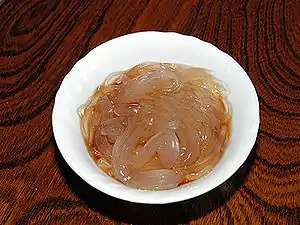Tokoroten
Tokoroten (心太, ところてん) is a dish in Japanese cuisine made from agarophytes. Tokoroten has been eaten by the Japanese for over a thousand years.[1] Tokoroten is thought to have been introduced to Japan from China during the Nara period.[2] Tokoroten was traditionally made by boiling tengusa (Gelidium amansii) and then allowing the mixture to congeal into a jelly.[1]
 | |
| Type | Wagashi |
|---|---|
| Place of origin | Japan |
| Main ingredients | seaweed (tengusa, ogonori) |
Tokoroten was a popular snack during the summertime in Edo (Tokyo) during the Edo period.[2] It was originally made to be eaten immediately and was commonly sold around factories.[3] In the 17th century, it was discovered that freezing tokoroten would result in a stable and dry product known as kanten (agar).[3][1] While tokoroten can be made from kanten based on seaweeds such as tengusa (Gelidiaceae) and ogonori (Gracilaria), today commercially produced kanten is mostly made from ogonori.[2]
Pressed against a device, the jelly is shaped into noodles. Unlike gelatin desserts, tokoroten has a firmer texture.
Tokoroten was and can be eaten hot (in solution) or cold (as a gel).[3] Flavorings and garnishes can vary from region to region. Today, it is the most common to eat tokoroten with a mixture of vinegar and soy sauce,[4] and sometimes nori,[5] hot pepper, or sesame. In Kansai region, tokoroten is eaten as a dessert with kuromitsu.[6]
Citations
- Mouritsen 2013, p. 93.
- Shimamura 2010.
- Armisen & Galatas 1987.
- Ito & Hori 1989.
- Stephen 1995.
- "ところてん、関西ではなぜ黒蜜?" [Why is tokoroten eaten with kuromitsu in Kansai?] (in Japanese). The Nikkei. 2014-06-25. Retrieved 2017-04-26.
References
 Media related to Tokoroten at Wikimedia Commons
Media related to Tokoroten at Wikimedia Commons
- Armisen, Rafael; Galatas, Fernando (1987). "PRODUCTION, PROPERTIES AND USES OF AGAR". In McHugh, Dennis J. (ed.). Production and utilization of products from commercial seaweeds. Food and Agriculture Organization. ISBN 9251026122.
- Ito, Keiji; Hori, Kanji (1989). "Seaweed: Chemical composition and potential food uses". Food Reviews International. 5 (1). doi:10.1080/87559128909540845.
- Mouritsen, Ole G. (2013). Seaweeds: edible, available, and sustainable. The University of Chicago Press. ISBN 9780226044361.
- Shimamura, Natsu (August 4, 2010). "Agar". The Tokyo Foundation. Retrieved 19 December 2016.
- Stephen, Allistair M. (1995). Food Polysaccharides and Their Applications. Taylor & Francis Group.
